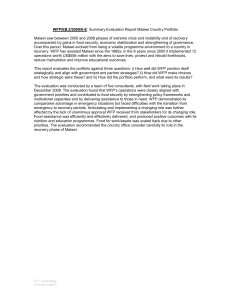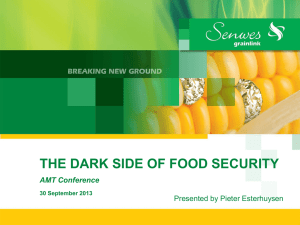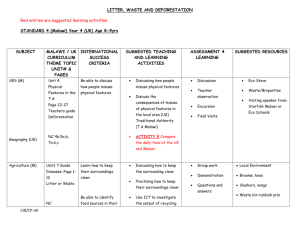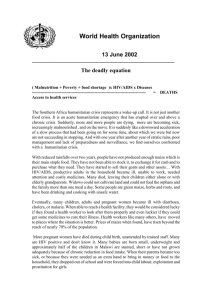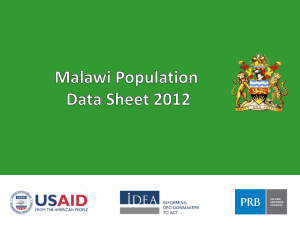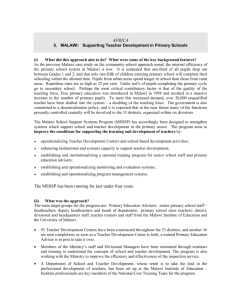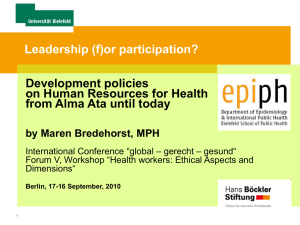What support will the UK provide? - Department for International
advertisement
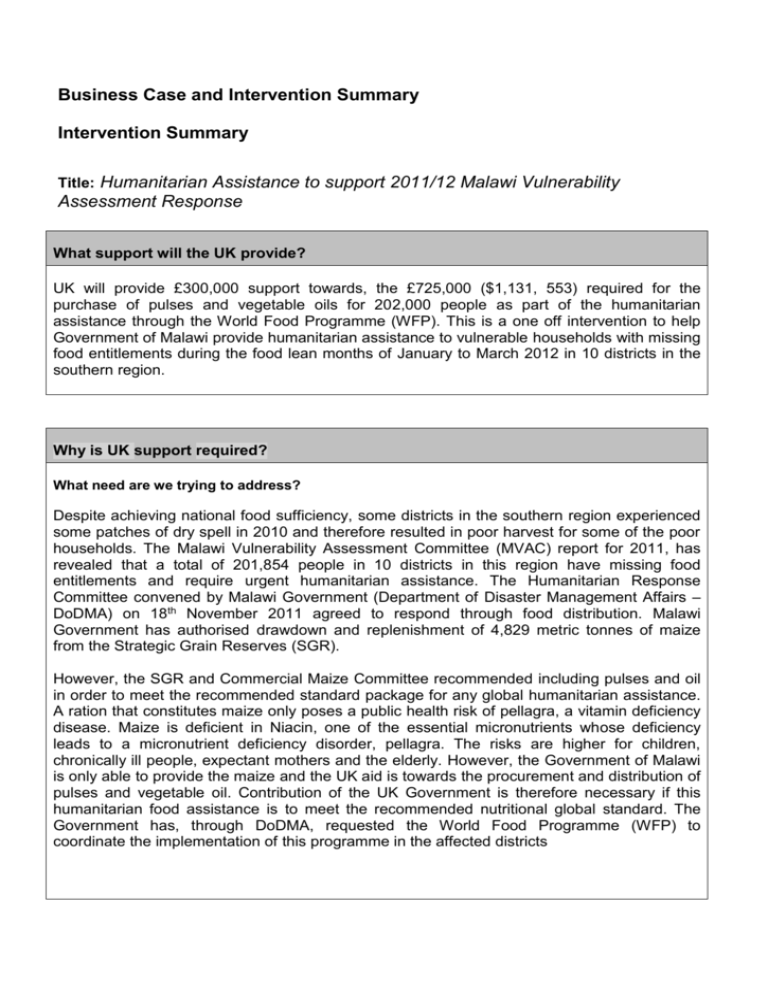
Business Case and Intervention Summary Intervention Summary Title: Humanitarian Assistance to support 2011/12 Malawi Vulnerability Assessment Response What support will the UK provide? UK will provide £300,000 support towards, the £725,000 ($1,131, 553) required for the purchase of pulses and vegetable oils for 202,000 people as part of the humanitarian assistance through the World Food Programme (WFP). This is a one off intervention to help Government of Malawi provide humanitarian assistance to vulnerable households with missing food entitlements during the food lean months of January to March 2012 in 10 districts in the southern region. Why is UK support required? What need are we trying to address? Despite achieving national food sufficiency, some districts in the southern region experienced some patches of dry spell in 2010 and therefore resulted in poor harvest for some of the poor households. The Malawi Vulnerability Assessment Committee (MVAC) report for 2011, has revealed that a total of 201,854 people in 10 districts in this region have missing food entitlements and require urgent humanitarian assistance. The Humanitarian Response Committee convened by Malawi Government (Department of Disaster Management Affairs – DoDMA) on 18th November 2011 agreed to respond through food distribution. Malawi Government has authorised drawdown and replenishment of 4,829 metric tonnes of maize from the Strategic Grain Reserves (SGR). However, the SGR and Commercial Maize Committee recommended including pulses and oil in order to meet the recommended standard package for any global humanitarian assistance. A ration that constitutes maize only poses a public health risk of pellagra, a vitamin deficiency disease. Maize is deficient in Niacin, one of the essential micronutrients whose deficiency leads to a micronutrient deficiency disorder, pellagra. The risks are higher for children, chronically ill people, expectant mothers and the elderly. However, the Government of Malawi is only able to provide the maize and the UK aid is towards the procurement and distribution of pulses and vegetable oil. Contribution of the UK Government is therefore necessary if this humanitarian food assistance is to meet the recommended nutritional global standard. The Government has, through DoDMA, requested the World Food Programme (WFP) to coordinate the implementation of this programme in the affected districts What will we do to tackle this problem? DFID will contribute £300,000, which is 41.4% of the required financial resources for procurement and distribution of pulses and vegetable oil to vulnerable food insecure families. Other partners contributing to this intervention are USAID, Irish Aid and WFP. Who will be implementing the support we provide? World Food Programme (WFP) has been requested by Malawi Government to coordinate the implementation of the food assistance programme. It is also helping to mobilise the resources for the pulses and vegetable oil. WFP will collaborate with District Councils in the respective districts and selected partner Non Governmental Organisations (NGOs) already working in the affected areas. What are the expected results? What will change? 201, 854 vulnerable people including women, pregnant and lactating mothers, children and the elderly will receive nutritionally well balanced and globally accepted food assistance comprising maize, pulses and vegetable in order to meet their food entitlements during the lean period of January to March 2012. This will help achieve the following: Prevent severe food shortages at household level that could lead to the deterioration of nutritional status and starvation; Safeguard the nutritional well being of the most vulnerable segments of the population Preserve productive and human assets ; Prevent distress migration from affected areas to urban centres and neighbouring districts; Prevent destructive coping mechanisms like pulling children out of school. What are the planned outputs attributable to UK support? Overall budget for procuring and distributing the pulses and vegetable oil component of the humanitarian response is £725,000 ($1,131, 553). UK support (£300k) 41% of this component will buy 973 metric tons pulses and 177 metric tons of vegetable oil for 201,854 identified vulnerable people and enough to provide cover for the three months lean period. How will we determine whether the expected results have been achieved? WFP will implement this as part of their existing Protracted Relief Recovery Project with an established monitoring, evaluation and learning system. They will provide DFID, other donors and Malawi Government with monthly updates and end of project report. Their monitoring and evaluation system has the following components: Output monitoring: WFP and their Implementing Partners will conduct monthly monitoring of operation indicators with regard to food distributions, and target beneficiaries. The indicators will include quantities and types of food commodities distributed; timeliness of distributions; number of beneficiaries by sex and age; number of recipients by sex. On the process and management, number of women in food management committees and particularly in decision-making positions will be closely followed. Post Distribution monitoring: Will be used to determine end use of food at beneficiary level - access to food, the use of food at household level, and their satisfaction of quantity and quality of the food. Outcome monitoring: To measure the effects of food assistance on current and future food security of households. Business Case Strategic Case A. Context and need for a DFID intervention A 1. Background on Malawi Malawi, with a fast growing population of 13.1 million people, one of the highest population densities in sub-Saharan Africa and a limited natural resource base, is one of the poorest countries in the world. GDP per capita is $348, the fourth lowest in the worldi. Thirty nine per cent of the population currently live below the national poverty line; and up to three-quarters live below the international poverty line of $1.25 dollars a dayii. According to the 2008 Population and Housing Census1, over half the population (51%) of Malawi are females. In terms of age, it is also a young population with about 46% below 15 years. Agriculture dominates Malawi’s economy, development and livelihoods. Over 90% of the poor are small or medium scale farmers in rural areas, mainly reliant on their crops for food, well-being and incomeiii. The agriculture is largely rain fed with some growing investments in irrigation. Climate variability poses some food security challenges when rains are unfavourable for crop production and result in reduced agricultural productivity. In recent years there has been prolonged dry spells in some districts in Southern Malawi and localised flooding in many parts of the country, leading to localised food deficits. In 2004, 5 million Malawians (40% of the population) required food aid to survive, following a severe drought and low agricultural productivity. DFID spent about £24 million towards food aid in response to the 2004 food crisis. In response to the food crisis in 2004, the Government of Malawi embarked on the Farm Input Subsidy Programme (FISP), to raise agricultural productivity by providing around half the population with affordable fertiliser and high quality maize and legume seeds. DFID has made a significant contribution to this programme over the years. The FISP has resulted in increased productivity with the country recording surplus production for over three consecutive years. Despite the national food security, there are some localised areas and households which are not food secure. This is a result of varying weather/ rainfall patterns and limited factors of production for the most 1 Malawi Government, National Statistical Office; Population and Housing Census 2008; Main Report, September 2009 vulnerable families. However, the population requiring food aid has significantly reduced over the years to 508,089 people reported last year (2010/2011) consumption year and 201, 854 for the current consumption year (2011/12). The Malawi Growth and Development Strategy (MGDS), 2006/7 to 2010/11, which is the overarching operational medium-term strategy framework, includes Social Protection & Disaster Risk Management as one of the six thematic areas. Among other things, the theme is aimed at preventing the vulnerable from slipping into poverty due to economic shocks. The next MGDS will continue to address these issues. A 2 Background on Food Insecure households from 2010/11 agriculture production The Malawi Vulnerability Assessment Committee (MVAC), based on the vulnerability assessment for 2011/12 consumption year, released in September, reported that despite high production of maize at national level, there are localized food deficit areas. These are mostly in the southern parts of Malawi. The assessments looked at factors contributing to reduction in people’s crop production, income generating activities, trade and markets, and economic indicators such as food prices to determine individual household access to food and non-food needs during the current consumption year (2011-2012). The MVAC report projects that a total of 201, 854 people, in the affected areas, will not meet their annual food requirements. Although these figures are not broken down most of those affected are likely to be children below 15 years and females as per population characteristics. These are in 10 affected districts and the periods for deficits vary from one district to another and ranges from 2 to 3 months. The vulnerable people are in selected parts of Nsanje, Chikhwawa, Balaka, Blantyre, Chiradzulu, Mwanza, Neno, Phalombe, Zomba, and Ntcheu districts. The food deficits will vary across the districts, ranging from 16% to 35%. Vulnerable households are those that will not be able to meet their annual minimum food requirements after exhausting own stocks and employing several coping strategies. The food deficit is a result of prolonged dry spells that were experienced nationwide but the southern region was the worst hit. The north and most of central region managed to recover from the impact of the dry spell thereby registering normal to above average crop production. The dry spells occurred at critical phases of crop development and maturity. Late planted crops and local varieties were severely affected thereby reducing yields and consequently production. The dry spells caused premature drying up of most crops especially maize and some cash crops like tobacco, flowering in cotton and pegging in groundnuts. Dry tolerant crops like cassava and sweet potatoes could not be planted during February and March due to moisture stress The MVAC estimated that approximately 4,800 metric tonnes (MT) of food assistance will be required between December 2011 and March 2012 to cover the deficit. The National Food Reserve Agency (NFRA) has sufficient stocks to meet the identified food needs with a stock of 148, 842 MT as of November 2011. A Food Security Outlook report for October 2011 to March 2012 from the Famine Early Warning Systems Network (FEWS NET), shows that the food security situation in southern Malawi is worsening with maize prices above the projected maximum for the period (as high as MK 50/Kg in Nsanje district) propelled by high transportation costs as a result of scarcity of fuel. MVAC projected a maximum price of MK 40/kg for the period. Chikhwawa district is projected to be worst hit because of the recent ban of sale of cattle and goats in a bid to contain the Food and Mouth Disease Outbreak in that district and this will affect ganyu (piece work) availability in the district. Cattle and goat sales are a key source of income for the better-off who in turn use the incomes to pay for ganyu labor. The government’s Department of Disaster Management Affairs (DoDMA) is responsible for leading on emergency preparedness, response and disaster risk reduction. There is now an established UN Humanitarian Country Team, chaired by the Resident Coordinator who also functions as the Humanitarian Coordinator. The cluster system has been established with Government support and coordination between the government and the UN appears to be functioning well. WFP is the lead UN agency on emergency food assistance and on logistics (it is the cluster lead on logistics). The proposed intervention falls within WFP’s mandate. A 3. Why it is right for DFID to intervene: In response to the need identified by the Malawi Vulnerability Assessment Committee (MVAC), the Malawi Government recently approved a humanitarian food assistance intervention covering all affected people. The Government has provided the required maize from the Strategic Grain Reserves for food assistance. WFP will provide funds to cover associated logistical and distribution costs. However, a diet of maize alone is below the minimum global standards for humanitarian assistance. It also has potential for causing nutritional disorders if taken over a long time. Also not responding would mean hunger and possibly malnutrition for those affected. It may also lead to destructive and unsustainable coping mechanisms. DFID makes a significant contribution to the Malawi Vulnerability Assessment Committee (MVAC) and production of the assessment reports. This intervention is a direct response to the MVAC findings and since the response is led by the Malawi Government, it strengthens the credibility of the MVAC findings. It should be noted that these vulnerability and localised food insecurity issues are recurring in the affected areas. To ensure sustainable response that builds resilience among the people, communities and support institutions and reduce risks, DFID has developed the Enhancing Community Resilience Programme (targeting these vulnerable areas). The package of activities under this programme includes agriculture production, which requires people to work in their field during this time. The intervention will enable affected families to access food. For those with productive capacity to use it working in their own gardens rather than selling their labour elsewhere in exchange for food or to earn money to buy food. If vulnerable families have food, they can use their time and labour on their fields and break the vicious circle of food insecurity and poverty. DFID also makes a significant contribution to the Farm Inputs Subsidy Programme (FISP), which is aimed at helping smallholder farmers improve agricultural productivity and production. Following the Humanitarian Emergency Response Review (HERR), Malawi is one of the priority countries for resilience and further work will be done by DFID Malawi to take forward the resilience agenda. A4. How DFID’s proposed intervention fits with other partners: The Malawi Government through WFP made an appeal for support and DFID will make a contribution to the total cost. USAID has contributed in kind 177 metric tonnes of vegetable oil valued at US$ 416,423, equivalent of £266,635 and Irish Aid will contribute about £160,000. The DFID contribution of £300,000 will enable WFP to fully meet the balance of the requirements. In implementating this programme WFP will follow guidelines from the Joint Emergency Food Aid Programme (JEFAP) Targeting Manual on Targeted Food Distributions to target the beneficiaries for this programme. Both social and economical indicators will be used to identify the most poor and vulnerable households2. Beneficiaries will be identified at household level following identification of the most vulnerable villages within the Traditional Authorities that were reported by the MVAC to be affected in the affected districts. Other operational approach details include the following: a) Beneficiary characteristics: The beneficiary households will include households caring for orphaned children less than 18 years old (where both parents have died); childheaded households (orphan-headed households or where the parent or grandparent is incapable of undertaking the usual head of household roles); elderly-headed households (more than 60 years old); households with chronically ill / HIV & AIDS affected members; female-headed households; households with two or more years of successive crop failure; and households with children receiving supplementary or therapeutic feeding b) Village level targeting: Consultations will be done at district level with District Agriculture Development Officers and their extension staff in order to effectively identify villages within a TA which are food insecure and eligible for food aid assistance. The lead NGOs in the districts together with the District Executive Committee (DEC) members and NGOs working in the districts will verify the names of the targeted households on their existence and vulnerability to be included as a benefiting household. c) Household level targeting: Households in need of food assistance will be identified and will include those that have limited or no source of income, income within the lowest community category and identified by the community or community organisation as in need of food assistance. Beneficiary enrolment will be done in collaboration with the project committee, and village civil protection committees. These committees are elected in a democratic manner by the whole community. The enrolment of targeted beneficiaries will be done in a transparent manner through village gatherings. The community will be sensitized about the programme regarding its targeting criteria so that they can be aware and clear on reasons why some households have been targeted while others left out. d) Beneficiary registration and verification: NGO partners will conduct community sensitizations; register targeted beneficiaries in liaison with the village civil protection committees. Verification is a continuous process of checking and eliminating inclusions errors, to make sure that the program targets the right beneficiaries. The District Councils will work in collaboration with the implementing partners to conduct verification of beneficiaries at community level through door to door, community random interviews (both non beneficiaries and beneficiaries). Both targeting and the exclusion criteria will be 2 See full proposal from WFP, attached for details used as checklist to determine inclusion and exclusion errors to verify the eligibility of the benefiting household3. e) Food distribution process: All identified beneficiaries will be registered in a Register book. All beneficiaries will be issued with ration cards that will be presented during the distribution day. All beneficiaries will receive ration cards and kept safe by themselves. Beneficiaries will be notified about the food distributions three days before the distribution day by the village civil protection committees with assistance from the village heads. B. Impact and Outcome that we expect to achieve Impact: Contribute to increased household food security for people affected by localized food shortages in 10 districts to prevent suffering, livelihood crisis and risk of mortality during periods of food stress Outcome: 201,856 Vulnerable households and individuals protected against hunger, malnutrition, n, , harmful levels of asset depletion and/or the undertaking of negative coping strategies. 3 See Annex 1 of the full proposal from WFP for details Appraisal Case A. What are the feasible options that address the need set out in the Strategic case? 1. Do Nothing – counterfactual 2. Contribute to Food Aid Assistance Response 3. Cash Transfers B. Assessing the strength of the evidence base for each feasible option In the table below the quality of evidence for each option is rated as either Strong, Medium or Limited Option 1 2 3 Evidence rating Limited Strong Limited Option 1. Do nothing: Maize from the Strategic Grain Reserves will still be distributed. Malawi Government have already authorised release and WFP have offered to provide the logistical and distribution costs. However, this ration will not be nutritious and does not meet the minimum global standards for humanitarian assistance. Option 2. Contribute to Food Aid Assistance Response: This is the favoured option because it is the approved response by the Malawi government and implementation will be coordinated by WFP. In view of the late decision by the Malawi government to respond, direct food assistance response is the most feasible and WFP will implement it as part of an existing “Protracted Relief Recovery Project” and can use existing stock to be replaced with new procurement. They have adequate capacity and existing partnerships and working relationships with District councils and partner implementing NGOs in the affected districts. This would facilitate a quick response since they have established systems and criteria for targeting, beneficiary registration and verification, and logistics for food procurement and distribution. USAID has made an in kind contribution of 176.6 metric tonnes of oil and only pulses will be procured and are available within the country. In 2010/11 consumption year, DFID also contributed £490,183 pounds ($776,835 to a food aid response to MVAC. WFP had dispatched 100 % of the distribution plan to two partner implementing NGOs so that by the end of the project both NGOs had distributed food to 100 % of the planned beneficiary number, and over 99% of the planned tonnage of food. Among the lessons learnt, the programme showed that using existing stocks helped with timely project implementation. Option 3: Cash Transfers: The Malawi Vulnerability Assessment Committee (MVAC) recommended cash transfers or public works in the affected areas to improve food access of the vulnerable groups through markets. But one of the assumptions for the MVAC findings and recommendations was that markets will function normally and local maize private traders will play their normal role of moving maize from surplus to deficit areas. This assumption is currently not holding. Reports from FEWS NET 4and the Strategic Grain 4 Fews Net; Malawi Food Security Update, November 2011 Reserves and Commercial Maize Committee, 5show that most markets in the Southern Region do not have maize in stock and for those that do it is in some cases of poor quality and not fit for human consumption. While the Agricultural Development and Marketing Corporation (ADMARC), has adequate stocks of maize in the country, most of this is held in the central and northern region. Despite growing demand in the south, they have not moved much stock there. Similarly, commercial traders’ maize stocks are also largely in the central and northern Region. This defeats another assumption in the MVAC report that Maize prices would remain relatively low (averaging MK32.5) for the rest of the consumption year from April 2011 to March 2012, with the maximum being MK40/kilogram. These prices were projected to stay low due to the high national maize production that was preceded by a favourable carryover stock of maize at household level, the Strategic Grain Reserves and ADMARC. As of November 2011, maize prices had already gone as high as MK 51/kilogram in some markets in the affected districts like Nsanje and Chiradzulu. High maize prices are resulting from fuel shortage leading to high transportation costs. Time factor is another challenge that would limit the effectiveness of this option even if the market situation improved. An effective Cash Transfer response requires a thorough Market Assessment, which takes time. In 2010/11 consumption year, DFID also supported a Cash Transfer Programme in Balaka district. The programme design and implementation confirmed that a Market Assessment is a major precondition for cash transfer programming in humanitarian responses. What is the likely impact (positive and negative) on climate change and environment for each feasible option? Climate change and environmental implications for the preferred option 2 are limited. However, if nothing is done, there is the risk that affected people will start over exploiting of local natural resources. Cutting down trees for firewood and charcoal for sale are among the common destructive coping mechanisms. Timely intervention by providing the required standard humanitarian response will, therefore, help to preserve the environment and natural resources in the area. Food aid will also help these vulnerable households to allocate the scarce labour in their gardens and follow modern cultivation practices, including various techniques of soil conservation and conservation farming being promoted in Malawi. summary of environmental and climate change assessment Option Climate change and environment risks Climate change and environment and impacts, Category (A, B, C, D) opportunities, Category (A, B, C, D) 1 C (do nothing) C 2 C B 3 C C C. What are the costs and benefits of each feasible option? 5 Minutes of the Strategic Grain Reserve and Commercial Maize Committee meeting held on 18 th November 2011 1. “Do Nothing” – Destructive, maize from the Strategic Grain Reserves will still be distributed. While this will enable the affected vulnerable people to access food, this is starch only and not nutritious. For children, people living with HIV, other chronically ill people, expectant mothers and the elderly, this may with time result in nutrition problems. This intervention could be a health hazard as it is not nutritionally balanced. 1. Food Aid Response: The total cost for this option is £725, 000 and will provide 202,000 people with pulses and vegetable oil over a three months period. Our support complements the Malawi Government contribution of maize drawn from its strategic grain reserve. It is important that the Government take the lead as a demonstration of strong political commitment to addressing hunger and also that the country has enough maize at national level (including its strategic grain reserves). Beneficiaries will get a nutritional ration that meets the minimum standards for humanitarian assistance. Other benefits of the food aid response include: a) Prevention of severe food shortages at household level that could lead to the deterioration of nutritional status and starvation; b) Safeguarding the nutritional well being of vulnerable segments of the population such as children, expectant and lactating women, and the elderly; c) Preserving productive and human assets; d) Preventing distress migration from affected areas to urban centres and neighbouring districts. 2. Cash Transfer: DFID experimented in 2010 with the cash transfer as another method to respond disasters (including food crisis). Our cash transfer programme with Oxfam last year, calculated the average cost per beneficiary to be £7.04 equivalent of ($11). For 202,000 beneficiaries and the project cost of £1, 421,052, per capita cost based on pulse and oil component would be almost the same (£7.03). However, the evaluation for this pilot cash transfer programme was less rigorous and therefore we treat its findings with a bit of caution. It is difficult to push for a cash transfer under the current circumstance for two reasons: setting up a thorough and strong system would require a bit of time and also, Government’s contribution is a draw down of maize from its strategic grain reserves. Cash transfer would easily work on the maize component rather than the oils and pulses we intend to support. It would be quite risky to give vulnerable households cash to buy vegetable oil, as they might prefer to use the cash on other household needs. Only few poor households in Malawi use vegetable oils as part of their meals. Therefore, targeted households may view oils as a luxury and not a necessary requirement for their diets. As such it would be quite risky to provide cash for these households and allow them make their own choice how to use it. D. What measures can be used to assess Value for Money for the intervention? The main measures to assess value for money for this response are through institutional reviews and assessments of DFID partners which have included value for money assessments. Central to this is the Multilateral Aid Review (MAR) which assessed VFM for each of the UN humanitarian agencies. For WFP, the MAR assessment indicates that WFP’s performance is strong in terms of contributing to UK development objectives – it plays a critical role in meeting international objectives. It is rated as satisfactory on ‘Cost and Value Consciousness’ - some of the elements highlighted include: Drives cost control with delivery partners. Has internal systems (including for procurement) to manage costs, driven by the Executive Board. Seeks value for money through local procurement and cost-efficient delivery tools such as electronic vouchers. Administration costs capped at 7 per cent overall. Is demonstrating cost efficiencies in a range of operations and has committed to a corporate efficiency strategy. Reflects strong corporate emphasis on costs/efficiencies coupled with business model improvements, with work underway at country level to keep costs down. E. Summary Value for Money Statement for the preferred option While directly addressing food insecurity at household level, the Food Aid Response will prevent targeted households (particularly the elderly, women and children) from severe hunger and malnutrition. Potentially, the intervention will help improve marginal labour output and also help affected households allocate their scarce labour for their own agriculture production. It will be more costly if these households are caught up in a vicious circle of food insecurity and poverty. Timely intervention will also prevent these households from indulging in destructive coping mechanisms, particularly on natural resources. Government has demonstrated strong commitment by drawing down maize from its strategic grain reserve. Government has enough maize at national level as a result of the farm input subsidy programme, which DFID and other development partners (Norway, Irish Aid and EU) have been supporting. This programme has helped to stabilise consumer prices of maize. Financial Case A. What are the costs, how are they profiled and how will you ensure accurate forecasting? DFID will be contributing £300,000 to a £725, 000 (equivalent of US$ 1, 131,553) project Budget for Pulses and Oil for the 2011/12 MVAC Response Programme District Affected population Number of HHs Maize equivalent gap (MT) No. of months Pulses Req. (MT) Oil Req. (MT) Commodity cost (US$) Associated Cost (US$) Balaka 8,658 1,575 157.4 2 32.0 5.8 27,801 9,392 37,193 23,815 Blantyre 24,111 4,384 438.4 2 88.0 16.0 76,569 25,847 102,416 65,577 Chiradzulu 24,217 4,404 660.5 3 133.0 24.1 115,532 39,033 154,565 98,968 Chikwawa 45,042 8,190 1,228.4 3 246.0 44.8 214,218 72,279 286,497 183,444 Mwanza 4,027 733 73.2 2 15.0 2.7 12,987 4,396 17,383 11,130 Neno 7,348 1,336 200.4 2 27.0 4.9 23,472 7,926 31,398 20,104 Ntcheu 29,251 5,319 531.8 2 107.0 19.4 92,973 31,407 124,380 79,641 Nsanje 23,850 4,337 650.5 3 131.0 23.7 113,705 38,434 152,139 97,415 Phalombe 11,665 2,121 318.1 3 64.0 11.6 55,601 18,784 74,385 47,629 Zomba 23,685 4,307 570.0 3 130.0 23.6 113,028 38,169 151,197 96,811 201,854.0 36,706 4,828.7 973.0 176.6 845,886.0 285,667.0 1,131,553.0 724,533.4 National Total Cost (US$) Total cost (£ equivalent) Ration per household: Maize 50 kg bag per household per month Pulses 10 kgs per household per month Oil 1.985 kgs (2 litres) per household per month B. How will it be funded: capital/programme/admin? The programme will be funded from programme resources available to DFID Malawi for 2011-12. C. How will funds be paid out? The total amount of £300,000 will be disbursed to WFP in the form of a Contribution Agreement upon approval of this business case. D. What is the assessment of financial risk and fraud? WFP will use their internal financial and management systems to manage this programme, which include risk management and fraud prevention. In the past, they have delivered similar responses with no reported incidences of fraud. E. How will expenditure be monitored, reported, and accounted for? This is a three months response and WFP will provide an end of project report including a financial report to all stakeholders. End of year accounts will also be used. Management Case A. What are the Management Arrangements for implementing the intervention? The Social Development Advisor in DFID Malawi will provide oversight. WFP will coordinate implementation of the response in partnership with the Department of Disaster Management Affairs. B. What are the risks and how these will be managed? The main risks for this intervention are: Market distortion: Since the proposed food distribution does not use market based interventions, it has potential to create some market distortions, particularly price distortion in the maize market. Extra maize brought into the affected areas may potentially push down maize prices and negatively impact on the private traders. To avoid this, WFP and its implementing partners will ensure that there is a strict identification and targeting process to ensure that only the most vulnerable, those that can’t afford to purchase food on the market, benefit from the intervention. This will help to reduce displacement rate and therefore ensure the local markets are not disturbed. The implementation will follow the Joint Emergency Food Assistance Programme (JEFAP) guidelines on targeting the beneficiaries - (see annex: proposal from WFP on details for targeting). Inaccessibility of roads due to heavy rains: Heavy rainfall might make some areas inaccessible to deliver food commodities for distribution. WFP will contract smaller sized vehicle transporters that can access most areas in the country. For the most difficult routes, WFP will deploy its strong heavy duty 4x4 trucks to access such specific routes to deliver the food. Rains falling on the distribution days might also disturb the food distributions. The distributions will be rescheduled on the following day for those that do not receive so that they can get their entitled rations. Fuel shortage (Diesel and Petrol): Malawi is currently experiencing fuel shortages, which might affect speedy distribution of the food aid with delays or non-deliveries to some of the targeted areas. WFP and DoDMA are working closely with the Malawi Energy Regulatory Authority (MERA) to prioritise distribution of this food aid to the affected areas. Strong Government commitment will also help that such assurances are met. Such arrangements are working smoothly in other key programmes with strong Government commitment such as the Farm Input Subsidy Programme (FISP). Delayed response: Results of the MVAC were released in September 2011 but Malawi Government only made a decision to respond in November 2011. Food in some areas is required from December and mobilisation of resources is only happening now. If this process delays further, some families may slip into stress level. In mitigation, WFP will start with the distribution of maize and oil, which are already available, at end December 2011 and include pulses in subsequent distributions. Gender related violence and transparency issues: Gender related violence and lack of transparency are other potential risks. Appropriate sensitization will be conducted to ensure that women and girls are protected from any abuse. Strong community participation will be encouraged to ensure they are sensitized on their entitlements and demand transparency in the distribution process. Communities will also be encouraged to report any incidents related to abuse and exploitation. Cases of sexual abuse will be dealt with accordingly through a complaints desk for further reference to law enforcement authorities. Information Education Communication materials will also be produced and distributed at the final distribution points for general awareness and advocacy. These will include posters and brochures highlighting ills of sexual exploitation and abuse. Security at a food distribution site: Malawi is generally a peaceful country and civil disturbances are rare. As such, we do not expect any serious incidence of disturbances and breach of peace at distribution sites. However, a series of precautionary measures will be taken into account so that risks associated to a food distribution can be considerably reduced. These include proper lay out of the distribution site; involvement of community leaders in crowd control; communicating information during the entire distribution process; proper staff management; showing entitlements to beneficiaries; providing basic indispensable material you must have to help you control the crowd; safe storage of commodities. C. What conditions apply (for financial aid only)? N/A D. How will progress and results be monitored, measured and evaluated? This is a 3 months response and WFP will provide an end of project report including narrative and financial reports to all stakeholders. Additionally, progress will be monitored through the Humanitarian Country Team meetings held monthly. DFID will undertake at least one monitoring visit during the programme period and regular desk reviews. Lograme Quest No of logframe for this intervention: i IMF Report 2009 World Development Indicators, April 2011 iii Agricultural Growth and Investment Options for Poverty Reduction in Malawi, Benin et al (2008) ii iii Delgado, C. L., et al. (1998). Agriculture Growth Linkages in Sub-Saharan Africa. Washington, DC: IFPRI. Compared links between agriculture and the wider economy in a number of countries in Africa, and demonstrate that $1 increase in agricultural output yields $1.88 in Burkina Faso and $1.48 in Zambia; $1.24-$1.48 in Senegal and $0.96 in Niger a non-agriculture economy.
